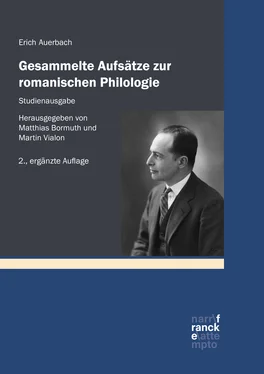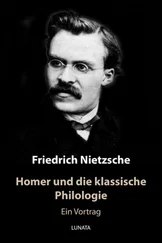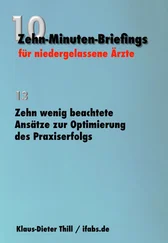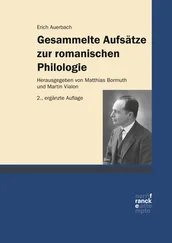DanteDante’s mind was deeply rooted in this tradition, and I believe that not only many particular passages in the Commedia can be explained in this manner, but that the whole conception of the great poem has to be considered from this angle. It is not difficult to prove that the community of the blessed in the Empireo , in which DanteDante’s Paradiso culminates, is arranged according to a figurative pattern. Not only the world of the Christian religion, but also the ancient world is included in DanteDante’s figural system; the Roman empire of AugustusAugustus is for DanteDante a figure of God’s eternal empire, and the prominent part Virgil plays in DanteDante’s work is based on this assumption. DanteDante is not the first to subject all the material of human history to the figural conception; biblical history, Jewish and Christian, came to be seen as universal human history, and all pagan historical material had to be inserted and adapted to this framework. Especially Roman history was interpreted by Saint AugustineAugustinus and other patristic authors as a path of Christan universal history and of the plan of providence. Medieval authors followed this tradition, and very often used it for political purposes, in the long struggle between imperium and sacerdotium imperium sacerdotium . So did DanteDante, and most of his figures taken from Roman history are connected with his political ideas, as the following example shows.
At the foot of the mountain of the Purgatorio , DanteDante and Virgil meet a venerable old man, who, with severe authority teaches them how to prepare for the ascent, as the guardian who controls access to purification. It is Cato of UticaCato v. Utica. The choice of this particular character for such a function is very astonishing. For Cato was a pagan; he was an enemy of CaesarCaesar and the monarchy; his allies, CaesarCaesar’s murderers BrutusBrutus and CassiusCassius, are put by DanteDante in the deepest hell, in Lucifer’s mouth by the side of Judas; moreover, Cato committed suicide, a crime for which horrible punishment is meted out in another circle of the Inferno. And yet Cato has been appointed as guardian of the Purgatorio! The problem becomes clear to us by the words with which Virgil addresses him: ‘I pray you, allow my companion to enter; he is in search of liberty, that precious good you know so well – you who have despised life for it; you know it well, because death was not bitter to you in Utica, where you abandoned your body that will be so radiant on the last day.’ From these words, it becomes obvious, that Cato is a figura , or better still, that the historical Cato is a figura figura of the Cato in DanteDante’s Purgatorio . The political and earthly freedom for which he died, was only a shadow, a prefiguration of Christian freedom from evil which leads from the bondage of corruption to true sovereignty over oneself, the libertas gloriae filiorum Dei – a freedom which DanteDante finally attains at the top of the Purgatorio , when Virgil crowns him as master over himself. Cato’s choice of voluntary death in order to avoid slavery is obviously considered by DanteDante not as a crime, but as a figura of this liberation. Of course DanteDante was inspired in the choice of Cato for this part by Virgil’s sixth book, where Cato is represented as a judge of the righteous in the netherworld ( secretosque pios, his dantem jura Catonem ) and he was encouraged to treat Cato in a special manner by the universal admiration expressed for him even by authors who were his political opponents. Cato was one of the classical examples of Roman virtue on which DanteDante based his political ideology of universal Roman monarchy. But the manner in which he introduced Cato and justified his part is independent of Virgil and is clearly figurative. Both forms of Cato are real and concrete, the historical and the eternal form; his function in the beyond presupposes the reality of his historical role. Cato is not an allegory nor a symbol of liberty, but an individual personality: he is raised from his preliminary status, where he considered political freedom as the highest good, to the final perfection of his form, in which civil virtue or law have lost their value, and in which the only thing of importance is the ben dell’intelletto , the true highest good, the liberty of the immortal soul in the sight of God.
In striking contrast to earlier poets who dealt with the other world, the inhabitants of DanteDante’s three realms have not lost the individual shape and strength of their earthly character; on the contrary, their individual character presents itself with an intensity and concreteness superior to what it was during the various stages of their earthly careers; and this realismRealismus in the beyond is allowed to survive in spite of the fact that they have left history for an eternal, and eternally unchanging, situation. This powerful realism is based on DanteDante’s conception, that God’s judgment develops and fixes the complete and ultimate form of the individual – a conception which is in concordance with Thomistic anthropology – and which at the same time is figuralistic: in that God’s judgment endows an earthly figure with its own final and absolute perfection.
Earlier poets never used figurism in such a universal and audacious manner; they confine figuralistic treatment in most cases to the poetical illustration of sacred history; figurative interpretationFiguraldeutung of other events or of life in general was mostly unconscious.
From the very beginning of Christian art and poetry, the figurae have a tendency to appear in series. These series of figures can be found already on the early Christian sarcophagi; we find for example the liberation of Joseph from the pit, the liberation of Jonah from the belly of the whale (after three days) and the resuscitation of Lazarus (also after three days) represented side by side as figures of Christ’s resurrection. But the full development of figurative series in Christian poetry is rather a medieval phenomenon than one of late antiquity. So far as I can see, the Latin hymnologists of the Carolingian periodKarolingerzeit, especially the inventor of the sequences, Notker BalbulusNotker Balbulus, were the first to use this form consciously; and the great master of what I may call figurative eulogies is Adam of St. VictorAdam v. St. Victor; the twelfth century is the apogee of figurism and especially of figurative series. The praise of the Virgin, for instance, in many of the sequences of Adam and his imitators, consists of just such series; she is represented successively as Sarah laughing at Isaac’s birth, Jacob’s ladder the top of which reaches to heaven, Moses’ burning bush which is not consumed by the flames, Aaron’s rod that budded, Gideon’s fleece soaked with dew, the ark of the Covenant that contains the celestial Manna, the throne or the bed of the true Solomon who is Christ, Isaiah’s rod coming out of the stem of Jesse, Ezechial’s gate looking towards the East which shall be shut because the Lord has entered by it; she is the garden enclosed, the fountain sealed, the fountain of gardens, the well of living waters from the Song of Songs, and so forth.
A student of mediaeval French literature may remember here the figurative series in the mystery plays, especially the most famous of them, the Jeu d’Adam Jeu d’Adam with its procession of prophets. These prophets are not prophets in the restricted sense in which we normally use this word, but Old TestamentaryAltes Testament personalities in general: besides Isaiah, Daniel and Jeremiah, there appear Abraham and Moses, David and Solomon, Balaam and Nebuchadnezar and others. Each of them begins with one Latin sentence isolated from the text of the Bible, and then goes on to explain the sentence in French as an announcement of Christ. Isaiah for example will not present the whole of his prophecy concerning the future of Jerusalem and the king of Babylon, but is introduced exclusively for the sake of one sentence: egredietur virga de radice Jesse etc., which was considered as a prediction of the Virgin and Christ; just as Abraham is introduced for the sake of the promise God made to him, and Aaron for his budding rod. This is pure figurism; as I have mentioned before, the Old TestamentAltes Testament becomes a succession of isolated prefigurations, or, if you prefer, figural prophecies of Christ. In this system even Adam may become not only a figura but a figural prophet of Christ. His sleep during which Eve, the mother of mankind in the flesh, was created out of one of his ribs, prefigures Christ’s death or sleep before his resurrection, when one of the soldiers with a spear pierced his side, and forthwith came there out blood and water, symbols of the sacraments of the Church, the mother of mankind in the spirit. Adam’s sleep is the mystical sleep of contemplation or ecstasy; when he awakens he starts prophesying: ‘therefore shall a man leave his father and his mother and shall cleave unto his wife, and they shall be one flesh’; this passage has been constantly interpreted as a figureFiguraldeutung of the union of Christ and the Church. This is one of the most ancient and venerable figures, one of the few introduced by Saint Paul himself (Eph: 5, 29–32): sacramentum hoc magnum est, ego autem dico in Christo et in ecclesia . This interpretation of Adam as a figurative prophet predicting Christ and the Church has become an unbroken tradition. I became aware of it for the first time when reading a sermonPredigt of Saint Bernard, the second in Septuagesima. The Jeu d’Adam Jeu d’Adam , it is true, does not present Adam in the procession of the prophets, but in another passage of the play he outspokenly predicts Christ. After his fall, when he gives himself up to despair and long-winded self-accusations, he sees one ray of hope: ‘There will be no salvation for me except by the son who will be born of the virgin’ – Deus … ne me ferat ja nul aïe, fors le fils qu’istra de Marie . In his deepest despair, he becomes conscious of the future redemption; he has knowledge of the future. This blithe anticipation of the future may appear to us as mediaeval naïveté , as a lack of historical perspective – the same historical naïveté with which Adam and Eve or in other plays other biblical personalities are realistically depicted as Frenchmen of the twelfth and the thirteenth centuries. And, of course, there is indeed implied, in such phenomena, a naïveté and lack of historical perspective; but such an evaluation would not be exhaustive. The figurative interpretationFiguraldeutung, in spite of its stress on historical completeness derives its inspiration from the eternal wisdom of God, in whose mind there does not exist a difference of time. In His sight, what happens here and now, has happened from the very beginning, and may recur at any moment in the flow of time. At any time, at any place, Adam falls, Christ sacrifices himself, and humanity, the bride of the Song of Songs, faithful, hopeful, and loving, searches for Him. A personality who is a figura figura Christi , as Adam is, has knowledge of the providential future – Christ knew that Judas would betray him, just as another figure of Christ, CharlemagneKarl d. Große, Charles li reis, nostre emperere maignes , in the Chanson de Roland Rolandslied , knows from the very beginning that Ganelon is a traitor. The eternal coexistence in God’s mind of all historical events is a conception best expressed by Saint Augustine’sAugustinus doctrine that God keeps present in his mind all things past and future in their true reality – that therefore it is not correct to speak of God’s fore-knowledge, but simply of his knowledge – scientia Dei non praescientia sed tantum scientia dici potest . Figurism gives the basis for the mediaeval fusion of realistic naïveté and other-worldly wisdom.
Читать дальше












